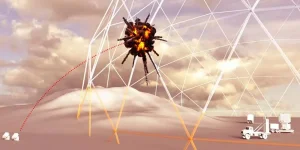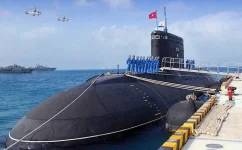- Views: 6K
- Replies: 14
India is advancing its goal of self-sufficiency in defence technology with Project Kusha, a domestically developed long-range air defence system spearheaded by the Defence Research and Development Organisation (DRDO).
This system is engineered to offer capabilities comparable to Russia's S-400 Triumf and is set to be a crucial component of India’s comprehensive air defence network.
Project Kusha will initially employ three types of interceptor missiles, designed to engage aerial threats such as stealth aircraft and ballistic missiles at distances of 150 km, 250 km, and 350 km.
Project Kusha represents the initial stage of a more extensive, phased initiative aimed at creating very long-range surface-to-air interceptor missiles, drawing on experience from India’s Ballistic Missile Defence (BMD) program. Future stages, potentially including Phase-II and Phase-III, are planned to incorporate capabilities such as defence against hypersonic threats.
This development indicates India's ambition to match or potentially exceed the performance of sophisticated systems like Russia’s S-500, heralding a significant evolution in the nation's strategic defence capabilities.
Further developments under Project Kusha are expected to include a Phase-II, which will concentrate on developing interceptor missiles with extended range and advanced features intended to equal or outperform Russia’s S-500 Prometheus system.
The S-500 is known for its ability to counter hypersonic missiles and engage targets up to 600 km away, placing it at the forefront of air defence technology.
Although detailed plans for Kusha’s Phase-II are not public, the DRDO aims to develop interceptors capable of reaching targets beyond 400 km. These will be equipped with upgraded sensors to effectively engage more elusive and high-speed threats.
This phase is also anticipated to feature improvements in radar systems, including an enhanced Swordfish Long Range Tracking Radar with a projected range of 1,500 km, alongside artificial intelligence-driven systems to aid in coordinating intercepts.
The goal of Phase-II to exceed S-500 capabilities addresses India's strategic requirement to counter the expanding missile arsenals of potential adversaries. This includes nations possessing long-range ballistic missiles and those involved in the transfer of medium-range missile systems in the region.
Developing the capacity to intercept such threats at greater distances is vital for protecting essential infrastructure, nuclear command facilities, and major cities.
This indigenous development aims to lessen India's dependence on imported defence systems, thereby strengthening its strategic independence.
Furthermore, Project Kusha is presented as a financially viable solution, with an estimated cost of ₹21,700 crore (approximately $2.6 billion USD) for five squadrons for the Indian Air Force, compared to the reported $5.25 billion cost for a similar number of S-400 units. This cost-effectiveness supports India's 'Atmanirbhar Bharat' (self-reliant India) policy.
Known alternatively as the Extended Range Air Defence System (ERADS) or Programme Long Range Surface-to-Air Missile (PGLRSAM), Project Kusha is a mobile, long-range air defence system.
It is intended to fill the operational space between India's current Medium-Range Surface-to-Air Missile (MR-SAM), which has an 80 km range, and the S-400 system, capable of reaching 400 km.
Project Kusha will utilize three distinct interceptor missiles, designated M1, M2, and M3, with engagement ranges of 150 km, 250 km, and 350 km, respectively.
As of August 2024, the M1 missile was reportedly in its manufacturing phase and scheduled for testing shortly; the DRDO has commissioned an initial set of components for this missile.
The M2 and M3 missiles, which are still in development, are designed to engage larger targets such as Airborne Warning and Control Systems (AWACS) up to 350 km away and will also offer capabilities for defending against short-to-medium-range ballistic missiles.
Project Kusha incorporates sophisticated long-range surveillance and fire control radars that can monitor airspace up to 500-600 km into adversarial territory. This provides early detection of various threats, including cruise missiles, stealth aircraft, drones, and precision-guided weapons.
The M1 and M2 interceptor missiles both use a 250 mm diameter 'kill vehicle' (the part that destroys the target), powered by a dual-pulse solid rocket motor and featuring thrust vector control for high agility in engaging targets up to 150 km.
The M3 missile, likely equipped with a larger 450 mm diameter kill vehicle, is designed for longer-range interception up to 350 km. It is stated to have a high success rate, with a single missile achieving at least an 85% probability of destroying a target, increasing to 98.5% when two missiles are fired in quick succession.
This multi-layered capability will provide extensive area defence for the Indian Air Force (IAF) and Indian Navy, with deployment anticipated around 2028–2029.
To accelerate development and enhance performance, Project Kusha will utilize technologies and missile designs from India's existing Ballistic Missile Defence (BMD) program for its interceptors.
For example, the M3 interceptor incorporates parts from current BMD missiles, making it particularly effective against long-range aerial threats such as AWACS aircraft and electronic warfare systems.
This sharing of technology between air defence and missile defence initiatives helps the DRDO lower development expenses and shorten project timelines, while also boosting the system's overall effectiveness.
The Indian Air Force (IAF) will lead the integration of Project Kusha into its Integrated Air Command and Control System (IACCS). This will ensure smooth operation alongside other air defence systems currently in use, such as the Akash, Barak-8, and the S-400, of which three units are reportedly operational on India's northern frontiers.




